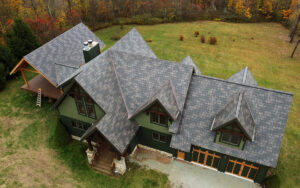By Jim Ryan
Some products seem to be just made for each other, and when “married” together, provide homeowners and businesses alike with benefits, both aesthetic and functional. Think of roofs and skylights, or roofs and gutters.
But even more complementary are roofs and rain water harvesting systems, especially when that roof is a metal roof, — the ideal catchment medium for rainwater harvesting (RWH). Rainwater is nature’s source of pure water, and like metal roofing systems, RWH systems have been refined with modern materials, engineering, and manufacturing techniques to make them an outstanding source of pure water for everyday domestic use. It’s not just for the garden anymore.
RWH is actually an ancient practice, used in India and the Middle East more than 2,000 years ago, then later by the Romans, and more recently by 19th century settlers as they cultivated the Midwest. After years of decline, rainwater harvesting today is enjoying a resurgence — though most is occurring outside the U.S. For instance, in Germany there are more than 400,000 systems installed; across the Caribbean 500,000 people depend upon rainwater harvesting systems; and in Australia more than 82 percent of people in rural areas rely on RWH systems for all their domestic water supplies.
Within the U.S., more and more people are installing systems, ranging from locations as diverse as Washington and Montana in the Northwest, and from Los Angeles to Texas, Florida and the U.S. Virgin Islands, where in fact RWH is required by law on all new construction. Some of these locations have very wet climates (Washington and Florida), while others have arid climates with more seasonal rains (Texas and Montana), but whether you’re in a wet or dry climate, a metal roof is the largest and best single investment one can make toward establishing a rainwater harvesting system.



What is driving this resurgence? There are actually multiple reasons. Sometimes it is a matter of water scarcity, sometimes it is due to poor water quality or even contamination, and sometimes it is just a striving for a sustainable and self-sufficient source of pure water. But one thing is certain: as populations grow and our demands for water continue to increase, the growing pressures upon our water resources will make scarcity, purity, and price more and more important issues for homeowners as they think about their water and their roof material — two things which until now they haven’t typically linked
Metal roofs are ideal for rainwater harvesting because:
• They are impervious, meaning that all the rain easily runs off without being absorbed.
• They generally have smooth surfaces, which the initial rainfall will easily clean of dust, bird droppings, and other potential contaminants (the RWH system uses a “first flush” water diverter to automatically exclude this “roof cleaning water” from going into a tank for storage).
• In dry or sunny regions the heat of the metal roof helps warm the initial rainwater to better clean the roof and gutters before water is diverted to storage.
• In areas prone to brush or forest fires, the combination of a metal roof and a cistern full of water can be easily used to protect homes at risk by reversing the flow, i.e. pumping water from storage to the downspouts until the gutters overflow, and thereby surrounding the home with a veil of water. The residents can even evacuate the home and allow the veil of water and metal roof to continue to protect the home while they escape to safety, as long as electricity and water are available to the pump.
• Metal roofs are tough. In areas where flooding or hurricanes are a threat (where there is too much rain?), rainwater harvesting systems can continue to provide sustainable pure water even when traditional sources of water are knocked out or contaminated. RWH systems can provide pure water even after residents lose electricity, or after groundwater and public systems are threatened by flooding and contamination.
I was in Tampa, Fla., recently on business, just in time to observe hurricane Frances and shortly after Hurricane Charley. I took advantage of the closed airport and my canceled business appointments to tour the coastal town of Punta Gorda where Charley suddenly veered east and hit with a vengeance. Now I understood the practicality of the 40-year guarantees offered by many metal roofers — because the majority of metal roofed structures were virtually untouched, while adjacent buildings with shingle and concrete tile roofs suffered significant damage or were destroyed. (A number of home owners associations have since removed their restrictions requiring all homes to have inferior roofing materials). In fact, much of the dangerous debris flying through the air during the storm’s high winds were these roof tiles and shingles — moving at 100-plus miles per hour.
Whether you are building, rebuilding or renovating, a metal roof is often the best option for achieving both aesthetics and functionality — especially when your home or business could also benefit from a rain water harvesting system. Metal roofs and RWH are two products which can be perfectly “married” to bring beautiful, safe, and sustainable living to their owners.
Remember, we are all downstream from someone! MR
Jim Ryan is a resident of Scottsdale, Ariz., and became an advocate for RWH systems after having purchased land along the Pacific coast of southern Nicaragua, where abundant rainfall and limited groundwater are the norm. He represents Rain Water Harvesting USA Pty Ltd. www.rainharvesting.com.






















